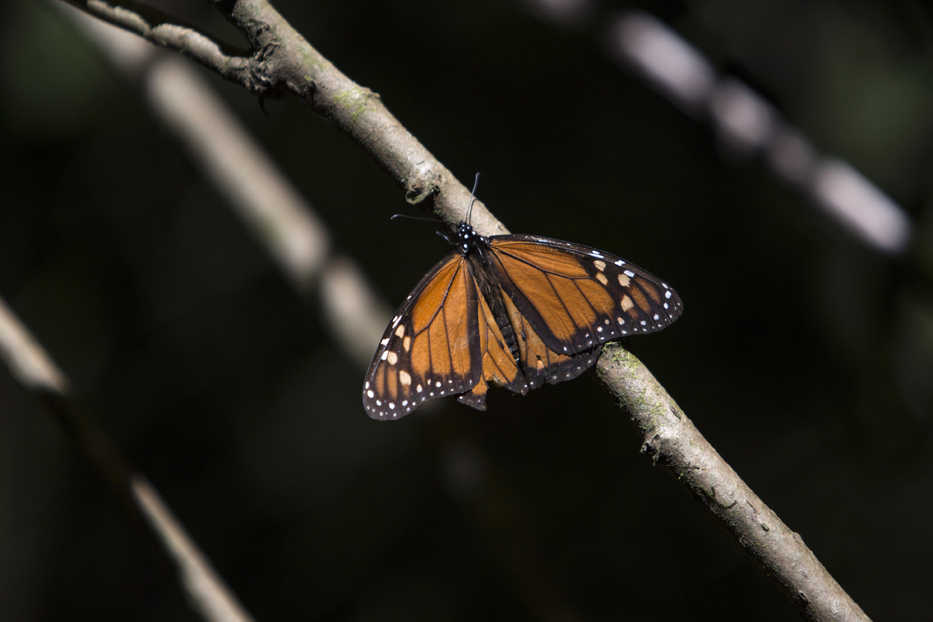PIEDRA HERRADA, Mexico — More Monarch butterflies appear to have made the long flight from the U.S. and Canada to their winter nesting ground in western Mexico, raising hopes after their number dropped to a record low last year. But experts still fear that unusual cold temperatures will threaten the orange and black insects.
While an official census won’t be ready until mid-January, observers are seeing healthy populations of butterflies bunched together on fir and pine trees in protected sanctuaries, said Gloria Talavera, director of the official monarch butterfly reserve.
“We’re encouraged, because we’ve seen more,” Talavera said Monday.
But cold forecast for this winter, she said, “could put at risk the whole migratory phenomenon. … We will be saying a prayer each day until mid-February.”
Mexico’s National Meteorological Service predicts 55 cold fronts for the country through May, a 15 percent increase from the average, and with the possibility for repeated cold systems to extend into March and April.
The temperate climate of the mountains west of Mexico City normally creates an ideal setting for the Monarchs. Every fall, tens of millions of the delicate creatures fly thousands of miles to their ancestral breeding grounds, creating clouds of butterflies. They clump together on trees, forming chandelier shapes of orange and black.
The migration is an inherited trait: No butterfly lives to make the full round trip, and it is unclear how they find the route back to the same patch of forest each year. Some scientists suggest the butterflies may release chemicals marking the migratory path and fear that if their numbers fall too low, the chemical traces will not be strong enough for others to follow.
The Monarch populations are being hurt by various factors: in Mexico, the encroachment of logging into their habitat; and in the United States, the decline of milkweed, the butterflies’ main source of food that has been crowded out by pesticide-resistant crops.
“The butterflies are at their most vulnerable moment because of pesticide use in the United States, climate change along their migratory route, and degradation of the forests where they winter,” said Homero Aridjis, a noted writer and environmentalist.
Observers count the Monarchs not individually, but by estimating how many acres they cover. Last year, after three years of steep and steady declines, the butterflies covered only 1.65 acres (0.67 hectares), their lowest level since record-keeping began in 1993. At their peak in 1996, the Monarchs covered more than 44.5 acres (18 hectares).
While the Monarch is not in danger of extinction, there are fears they could stop migrating or migrate elsewhere.
Environmentalists say large-scale illegal logging has declined drastically in the reserve, but small-scale logging by the mainly Indian farm communities that actually own the land remains a stubborn problem. Holes in the forest canopy make the butterflies more vulnerable to freezing weather.
Talavera said cold weather is the biggest threat to the Monarchs between now and March, when they take flight back north. Observers have noted unusual behavior in how they clump together, suggesting the insects are preparing for below-normal temperatures.
“They are seeking out canyons, seeking out more protected areas,” Talavera said. “We are seeing unusual things, all of them related to the climate.”
The butterflies also reached Mexico weeks later than normal, returning in mid-November rather than in time for the Day of the Dead holiday on Nov. 1, which locals long have associated with their arrival.
“They are like part of the souls that come back for the Day of the Dead,” said Jorge Dominguez Reyes, a leader of the San Mateo Almomoloa farm community that runs the Piedra Herrada butterfly sanctuary.
The Monarchs have been a key attraction for tourists who visit reserves like Piedra Herrada. But such visits have been hurt by a crime wave in the nearby lake resort of Valle de Bravo and any sustained decline in butterfly numbers would be a cruel blow. The community, in fact, has formed a 10-member patrol to keep loggers out of the nesting grounds in order to protect their habitat, Dominguez Reyes said.
“The butterflies,” he said, “give us more incentive to take care of the forest.”

